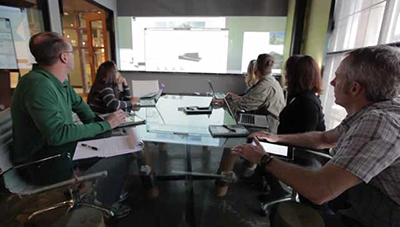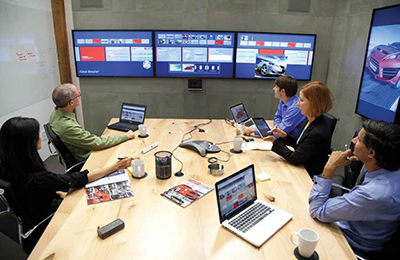Is hardware in AV a disappearing act? Which came first, the ever-changing AV integration business model or advances in technology?
Oblong Industries’ Mezzanine, which made its debut at InfoComm, is a collaborative conference room solution that allows for multi-user, multi-screen, multi-device collaboration. Any person on a network can bring their own device and share content and applications.
Firstly, hardware-free AV is a misnomer, said Rob Balgley, CEO of Mersive. “It’s actually more accurate to think of it as nonproprietary hardware or commodity, commercial off-the-shelf (COTS) hardware like a Windows 7 PC or an Android platform. The benefits are more than just reductions in capital expenditure; there are also reductions in maintenance and support because the skill required to support these standardized platforms is far less specialized and subsequently less pricey.
AV designs can be simplified with standard computer platforms and software-based solutions because software offers greater flexibility resulting in less project complexity and faster deployments.
“It’s also true that standard computer, graphics processing, and network technology platforms have all benefitted from the impact of Moore’s Law, which states that the current pace of improvements in semiconductor technology results in the doubling of speed, capacity, and throughput every 18 months, which is not true of specialized proprietary hardware,” he added. “This exponential rate of improvement, combined with cost-effective software solutions running on these standard hardware platforms, will steadily usurp traditional AV technology strongholds in control, distribution, and management systems.”
Mersive founder and CTO Christopher Jaynes said it’s no surprise that technology trends tend to lead transitions in business models. “A new technology becomes available and, over several years, the way it is delivered, integrated, and sold adapts.”
Examples from the past decade include the shift from analog to digital video and the introduction of video over IP. “The major technology trend in the AV space over the past 15 years is the introduction of flexible software and commodity computing equipment as a viable replacement for custom hardware,” he noted. “What were once expensive, custom video processors are now composed of commodity CPUs and network interface cards on a standard computer running software.”
Video streaming over wireless networks, webcasting, HT ML5-capable hardware video decoders, and cloud-based media servers will continue this trend. The good news, said Jaynes, is that software is flexible and can be integrated with other technologies more easily than hardware-based systems. “AV integrators who embrace software will be able to provide more value to their customers by supplying complete solutions that are deeply integrated. Examples include collaboration software in the conference room that is integrated with their room scheduling systems, the video teleconferencing codecs, and even their traditional in-room control panels.”
The Right to be Free of Friction
Hardware isn’t disappearing per se, said David Kung, vice president of business development at Oblong Industries. “Instead, what we’re seeing are the functions of dedicated hardware now dispersing across multiple devices and a parallel shift in the kind of functionality which solely resides in a dedicated appliance or within devices, displays, and the cloud.”
There will continue to be a role for dedicated hardware, so we may never be completely hardware-free, but we all aspire to being friction-free, he explained. “We want shared content and shared workspaces without having to jump through multiple hoops and patch together different solutions to get there.”
Hardwired video connections are already being displaced by wireless options, and dedicated video codecs are being displaced by a combination of lower-cost hardware and cloud-based solutions.
“The master room control remote will likely remain a fixture,” Kung added. “But, we see mobile clients providing comparable functionality and, most likely, increased usability as a result of being freed from the cycles of producing hardware. While hardware will still be present, it may become more transparent as controls are displaced from installed hardware in the room to software controls resident on the devices that participants bring into the room.”
See It, Hear It
The most significant change in a hardware-free AV system is clearly going to be in video conferencing, said Mark Madison, executive vice president of systems integration at CompView. “With companies like Google and Microsoft claiming to be very close to that literally being built into everyone’s browser, the need for other products and services will be severely diminished. The advances in VC cloud infrastructure and the reduced costs of increased bandwidth is having a major impact on the traditional VC solutions.”
Secondly, he noted, is the migration to IP distribution of AV signals being controlled by software systems. “As the AV backbone becomes more IT oriented it will change the entire industry and the type of people working in it.”
It’s a Broad, Broad World
The attendant benefits of the transition from specialized hardware to commodity hardware and software means that high-performance AV solutions are now available to a broader market, which in turn means higher volumes, increased competition, and more aggressive technology innovation, Balgley maintained.

“We want shared content and shared workspaces without having to jump through multiple hoops and patch together different solutions to get there,” said David Kung, vice president of business development at Oblong Industries. “All of this results in better products at lower prices. Some obvious examples of this trend are in video teleconferencing which has been revolutionized by ‘soft codecs’ making the technology to more users in more applications, which in turn changes the use case criteria resulting in even faster growth and adoption.”
Wireless technology is another good example of how Moore’s Law has accelerated performance to the point where cables are no longer needed; cost comes down, flexibility of deployments goes up, and use cases proliferate to include new and innovative applications.
“The explosive growth of wireless content sharing is now possible because of advancements in wireless technology speed and throughout in smaller and less expensive packages,” Balgley said, “which, when combined with cheap computer processing and smart software, can make switches, controllers, and cabling a thing of the past.”
Evolution
A general rule of technology holds that hardware systems always evolve towards more commodity, lower-cost, general-purpose platforms with the slack being taken up by increasingly sophisticated software, Jaynes stated. “The first telephone systems required entire buildings to house custom switching hardware commissioned and built by the Bell telephone company. That same network hardware is embodied in the general-purpose WAPs and switches of the internet.”
At the same time, he said, the value your service provider offers is in their routing and wireless hand-off algorithms, their noise-suppression capabilities, and the ease in which you can manage and make a call on your cellphone. “In short, the value is in software running on the commodity internet hardware. This same trend has played out in almost all other aspects of computing—disk drives, cluster computing, print services, etc., and it is just now accelerating in the AV market.”
Jaynes predicted back in 2007 that HD video transport over wireless would be a possibility by 2010 and, with the help of the National Science Foundation, Mersive began building the architecture for a wireless video transport architecture in software.

Mersive introduced an update to its Solstice platform, a media sharing and collaboration tool, at InfoComm. Solstice enables multiple users to connect simultaneously to a shared display using a range of devices over an existing WiFi or ethernet network. “I was off in my predictions by about two years,” he conceded, “so I hesitate to predict what will be wireless next. However, I can say that many large enterprises already have a clear program in place to remove the video cables from all of their office spaces in the next 18 months. If I had to guess, there are several areas where wireless transport will impact AV. Your computing environment will undergo the same transition. That is, the concept of a desktop that is attached to your personal computing device, with its various windows and applications left open when you go home at night and then waiting for you when you return, will certainly be replaced by a virtual desktop in the cloud, accessible anywhere in the next few years. Digital signage systems will transition to wireless video transport in the next few years, along with other public display infrastructure.”
This will open new interaction and collaboration models for integrators to contemplate. “Finally, on-premise digital media switching and control systems will migrate away from miles of cabling embedded in walls and become wireless in the next five years.”
The AV industry has a rich future, Jaynes agreed. “After all, audio and video are both input-output devices that need to interact with customers directly and, as a result, will never be replaced by software running in the cloud. AV integrators should focus on providing high-quality endpoints that are interconnected through software. Endpoints that deliver beautiful, immersive, high-resolution display experiences and high-fidelity audio rendering and capturing will always be important.”
However, how those endpoints are controlled, connected, and integrated will be defined by software and commodity hardware. “Anything that doesn’t fall into one of those categories today is likely to go away,” he cautioned. “Examples include expensive video routers, hardware-based video codecs, and video switches.”
But what the removal of dedicated connectors or interfaces suggests is less about the boxes that will no longer exist and more about the functions currently residing in dedicated hardware that will no longer exist, Kung noted. “What’s even more exciting is the new functionality that dedicated hardware will bring: improved sensing, improved inputs, improved integration with other services, and more. It’s an exciting future ahead!”
Karen Mitchell is a freelance writer living in Boulder, CO.
Never Fade Away
Some AV hardware will never disappear, at least not in our lifetime.
For example, it is unlikely that the use of microphones, speakers, and amplifiers will ever cease, noted Daniel Routman, sales engineer for Ford AV. “A microphone converts sound to an electrical signal which gets boosted by an amplifier and reproduced by a loudspeaker diaphragm. The technology of capturing and reproducing sound has remained largely unchanged for over 100 years, and is likely to remain that way.”
In fact, transducers, anything that converts something to electrons or converts electrons to something else, will not go away, said Ben Bausher, senior consultant for the audio and video systems group at Jaffe Holden. “In addition to the audio side— microphones, preamps, amplifiers, and speakers—the video hardware that will remain includes cameras and display units, whether they are monitors, projectors, LED arrays, etc. Also, if we are virtualizing everything else, there will need to be a computer somewhere along the line to run it all.”
—K.M.
How We Say It
For those willing to keep their eyes wide open, the delightfully overwhelming nature of InfoComm has made it the perfect place for technological serendipity, said Michael Colburn, senior designer at RTKL. “For years, manufacturers, contractors, and consultants debated the apparent approach of convergence. Now we’re focusing on debating its proper role or method of implementation. This conversation is couched in meaningful and often adversarial terms such as ‘for-or-against’, ‘obsolete’, or ‘unstable’, even though the truth is more gray than black and white. More interesting by far though is what has been happening on the fringes of this conversation.”
The same technology that has driven the convergence of AV and IT fields is also bringing us new technologies that were never a part of traditional AV designs, and it’s these areas that Colburn finds fascinating. “I’m most interested in the new services that cloud computing, big data, and even the Internet of Things have made possible. We are starting to see signs that future conference rooms could include services such as automated speech-to-speech language translation, automated note-taking, and further advances in responsive room environments.”
Microsoft Skype is rolling out real-time translation to assist in calls between participants speaking different languages, something that previously would have required simultaneous interpretation even for a quick chat. Several startups, Colburn noted, including Gridspace, are trying to help companies capture intellectual property and add tagging automatically, something that could never be done with a traditional microphone and amplifier. “Cisco, IBM, Siemens, and a host of IT industry stalwarts are trying to make everything in our environment responsive, sense-able, and intelligent through sensor networks, integrated connectivity, and software programming. This is but a small sampling of the new crop of enabling technologies that are sneaking into our clients’ world.
“Debating the pace of convergence in our schools, offices, and homes seems shortsighted. We’re talking about whether one dedicated appliance computer can be replaced by a general-purpose workstation computer. Meanwhile the means to completely transform what it means to meet, to collaborate, and to communicate is evolving all around us. Manufacturers, contractors, and consultants would all do well to keep their eyes on the big picture and figure out models for how we help our clients select and implement the best combination of hardware, infrastructure, and services to meet their needs.”
—K.M.
